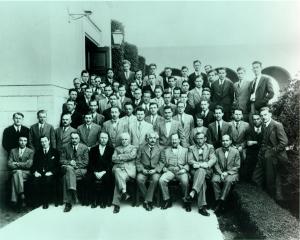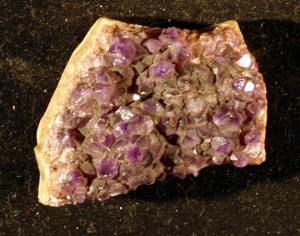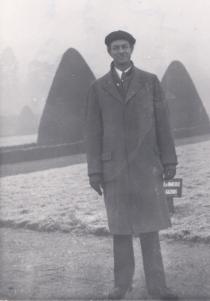
Group photo of Caltech Physics faculty and graduate students, taken on the occasion of a visit to Pasadena by Albert Einstein, 1931. Robert Oppenheimer sits in the front frow, far left.
[Part 1 of 3]
Similar in age, Linus Pauling and J. Robert Oppenheimer studied in Europe at the same time, and it was there that Linus and Ave Helen first met Oppenheimer, in June 1927.
In 1928, after his European studies had concluded, Oppenheimer’s path crossed once again with Linus Pauling, when Oppenheimer was approached with the offer of a split position between Caltech and Berkeley. Oppenheimer accepted this arrangement and maintained it for the next thirteen years, despite institutional tensions that arose between the two schools as a result of the agreement.
For Oppenheimer, the scenario was ideal. In Berkeley he kept a foothold at a university that was not a center for theoretical physics. He did so in part because he knew that he could help to develop the program and maintain a degree of control over it. On the flipside, Caltech offered the opportunity to foster closer ties with the larger physics community and to stay in touch with recent developments in the field.
Pauling biographer Thomas Hager notes that when Oppenheimer arrived in Pasadena, “Pauling and Ava Helen found him witty, interesting, and a welcome antidote to the deadly dullness of most of the Caltech faculty.” They became friends almost immediately; indeed perhaps too fast, as Pauling soon began to feel that things between the two men were somehow off.

“Epithalamion,” one of eleven poems written by Oppenheimer and given to Pauling in 1928.
Over the course of their brief friendship, Oppenheimer gave Pauling a range of gifts on multiple occasions, most notable among them a series of eleven poems that he had written. The poems, which Pauling saved, contain a mixture of nature themes and ruminations on love in a variety of forms. The inclusion of the latter perhaps underscores Oppenheimer’s respect for and feelings of close connection to Pauling. The fact that the poems would seem to be so personal is also a seeming indication of Oppenheimer’s level of comfort with Pauling during this phase of their relationship.
At the time, Pauling and Oppenheimer were also interested in similar scientific topics, and eventually Pauling would famously publish on one of Oppenheimer’s favorite topics, chemical bonding. (Or, as Oppenheimer defined it, “what makes a molecule a molecule.”) Before their friendship deteriorated, the two had even discussed working together on a project concerning the nature of the chemical bond, one which Pauling, of course, later conducted on his own.

Amethyst crystal given to Pauling by Oppenheimer in the early 1930s.
Oppenheimer was also interested in the crystal structure of minerals and had published several articles on the topic, which had likewise been a component of Pauling’s doctoral dissertation. As another act of kindness and respect, Oppenheimer gave Pauling his mineral collection, which he had been curating since he was five years old, when his grandfather gave him his first samples and prompted his interest in science. Pauling, who was a rock collector himself, not only saved the crystals, but also used them in his own research.
Oppenheimer seemed to mimic Pauling in style as well. Not only did he tailor his lectures to follow the patterns and methods that Pauling had come to adopt, but he also began to wear an old fedora, one which was very similar to a hat that Pauling liked to wear. In fact, the souring of his relationship with Oppenheimer may have resulted in a notable sartorial change as, in the recollection of Linus Pauling, Jr., the elder Pauling made the switch to his famous beret in part to distinguish himself from Oppenheimer’s flat-rimmed chapeau.
The friendship between Pauling and Oppenheimer came to an end when Oppenheimer invited Ava Helen to travel with him to Mexico. Ava Helen refused, explaining that she was married, and that this was a commitment that she took quite seriously. When she reported the incident to her husband later that evening, Pauling immediately cut ties with Oppenheimer, ending any potential collaborations that had been discussed and leading to a pronounced coolness between the two men.
Their relationship would continue to be strained until Oppenheimer’s death on February 18, 1967. Later in life, Ava Helen suggested it was not she with whom Oppenheimer had been infatuated, but rather her husband. After thinking it over, Linus came to the conclusion that this indeed had been very possible.

Pauling wearing his beret, 1948.
In the years that followed, the former friends did not stay in touch, but Pauling kept track of Oppenheimer’s career at Berkeley and knew of the top secret project that Oppenheimer was leading for the United States military during World War II. That program, of course, was the Manhattan Project, which would produce the atom bombs that were used on Hiroshima and Nagasaki at the end of the war.
In early 1943, Oppenheimer approached Pauling with the offer that he lead the chemistry division for this secret project, but Pauling refused. It is important to note, however, that he did not decline on grounds of the immorality of nuclear weapons development, as he likely would have later in life, but because he found the notion of working under the supervision of physicists, especially Oppenheimer, undesirable.
Furthermore, accepting the offer would require that he relocate his family to an isolated former boys’ school in New Mexico. This prospect seemed especially undesirable given that Pauling was already leading a broad war work program from the comfort of his home laboratory in Pasadena.
The conclusion of World War II and the onset of the atomic era brought about a change of perspective for both Pauling and Oppenheimer. Pauling’s vigorous program of peace work essentially began with the atomic bombings of Hiroshima and Nagasaki.
Oppenheimer was also deeply impacted by the project that he had led and the subsequent use of nuclear weapons in Japan. After the initial Trinity test in July 1945, Oppenheimer was famously struck by the power of these new weapons and was reminded of a quote from the Bhagavad Gita, “Now I am become Death, the destroyer of worlds.” He imagined that this feeling was shared by many of the colleagues with whom he had worked on the Manhattan Project.
In 1947 the two scientists’ lives would intersect again, when Pauling vouched for Oppenheimer’s loyalty during an FBI investigation. However, despite this offer of support, Pauling still did not feel that Oppenheimer should be nominated to the Atomic Energy Commission (AEC) board, due to “personal characteristics.”
When formal loyalty charges were brought against Oppenheimer by the AEC in December 1953, Pauling again spoke out against the treatment that he was receiving. As we’ll examine in greater detail in our next two blog posts, Oppenheimer was ultimately blacklisted primarily for the very charges of communist involvement that had been issued in 1947 and deemed at the time inconsequential, with the addition of one new charge that he had hindered the development of the hydrogen bomb by slowing down its progress. Shackled by these accusations, the former head of the Manhattan Project was now cut off from the work that he had been doing, work that had brought him great acclaim.
In truth, had Oppenheimer been a scientist of lesser standing, he would have lost his security clearance long before 1954. However, he was not an unknown scientist; he was important and vital to the atomic effort during the war and continued to be essential after the war ended. Despite questions about potential communist sympathies, his background was tolerated on account of his tremendous skillset as a scientist. But as we will see, all of this came to a head in Oppenheimer’s 1954 security hearing – “a disgraceful act” in the estimation of one former friend.
